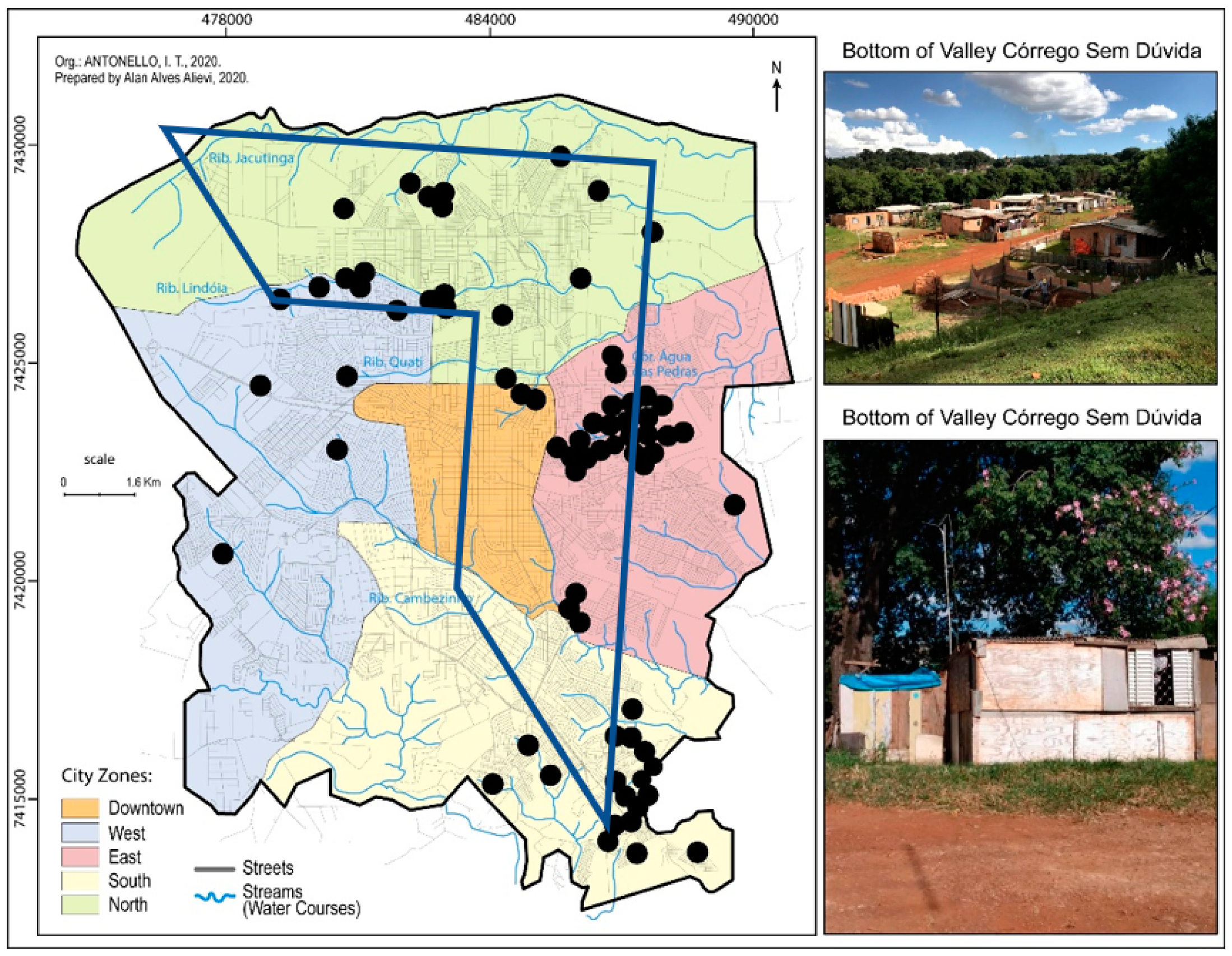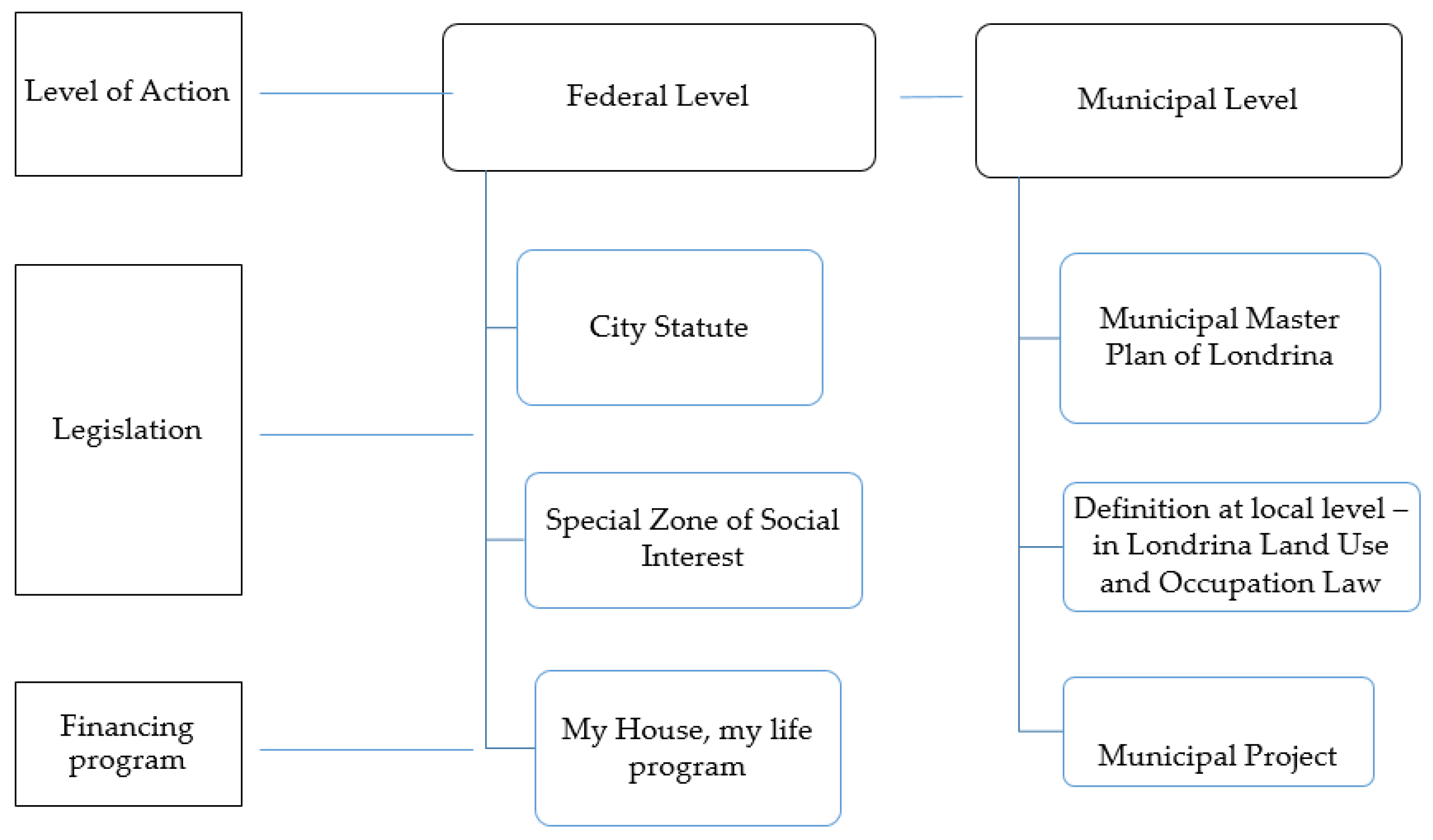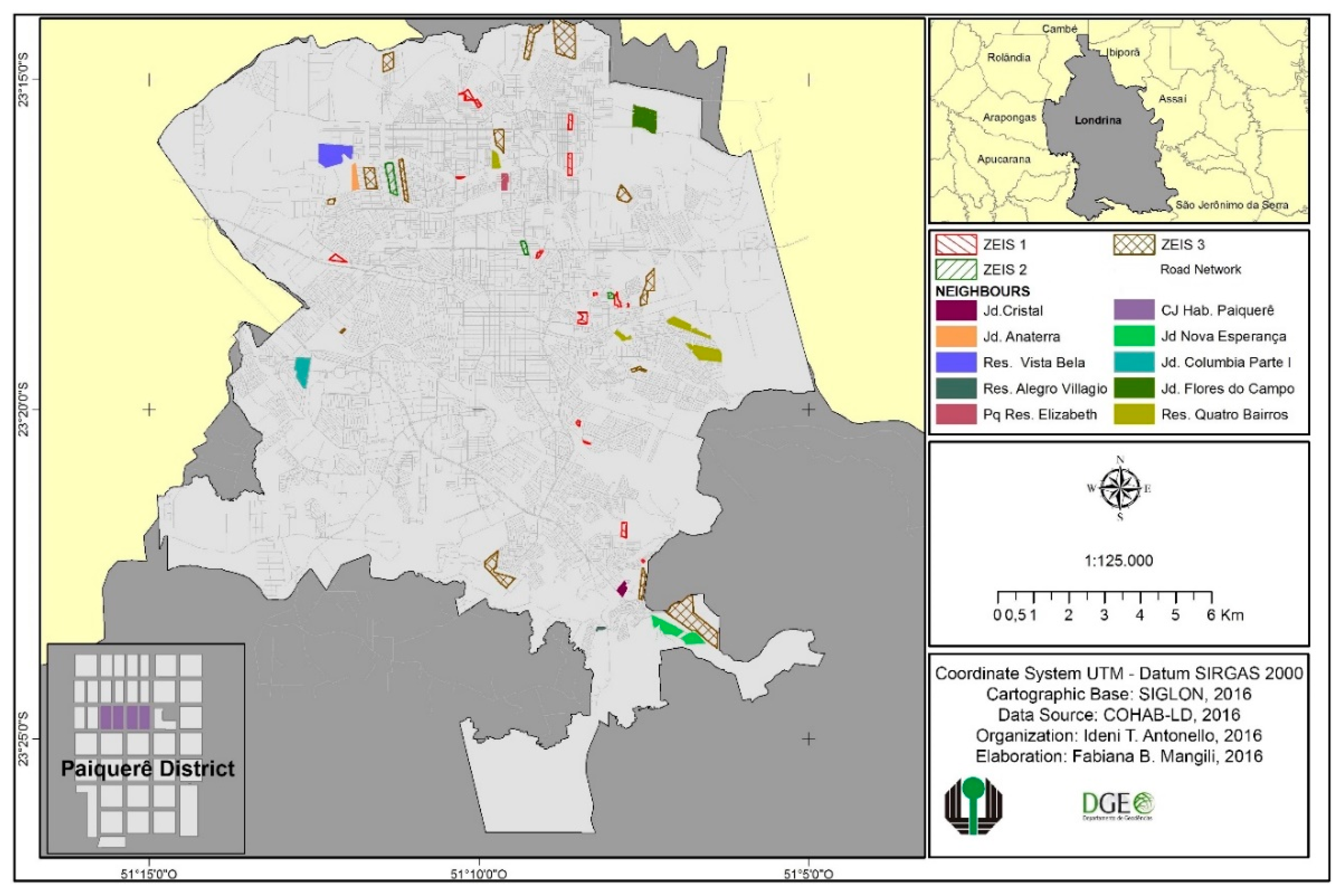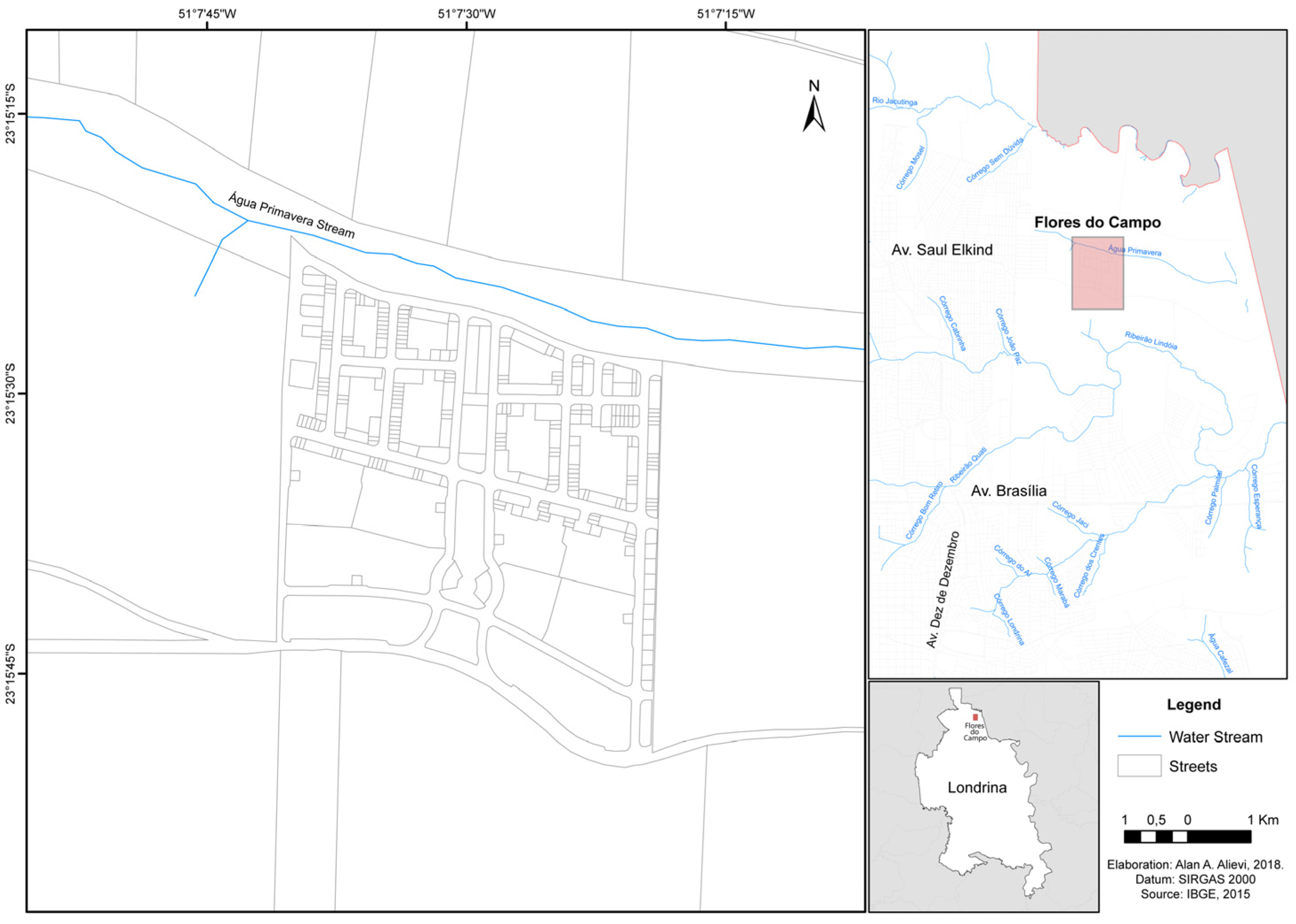Urban Planning and Residential Segregation in Brazil—The Failure of the “Special Zone of Social Interest” Instrument in Londrina City (PR)
Abstract
1. Introduction
2. Theoretical Support
- −
- As instruments of land regularization for urbanization of areas occupied by low-income population, through the simplification of the legislation on land parceling, land use, occupation and building rules;
- −
- Or by expanding the supply of housing for the low-income population by allocating new areas for the execution of new housing projects of social interest.
3. Materials, Methods and the Studied Area
4. Housing Needs and Policy Responses in the Municipality of Londrina/PR
4.1. Housing Needs in Londrina
4.2. The Instruments of Municipal Urban Planning in Londrina and Their Coherence with the City Statute
5. Discussion about the Inefficiency of the ZEIS to Fight Social Segregation
- I.
- ZEIS 1: public or private areas informally occupied by socially vulnerable population segments, in which there is public interest in promoting housing programs of social interest and land regularization, urbanistic and legal, as a result of the Urbanization Plan—PU, as established by law;
- II.
- ZEIS 2: areas of irregular and even clandestine housing estates, of social interest, and preferably of socially vulnerable population segments, executed by the public or private entrepreneurs, which have availability to regularize the properties according to current legislation; and
- III.
- ZEIS 3: tracks and land not parceled out or not built, not used or underused for urban purposes, as well as buildings not used or underused, located primarily in areas where there is urban infrastructure or on land on which there is interest in promoting housing programs of social interest (Londrina, 2015)”.
6. Conclusions
- −
- Improve the quality of the diagnosis and attend to strategic planning principles; consider future scenarios of population and economic activities demand and promote their location based on functional mix, social mix and minimal infrastructure/services attendance;
- −
- Related to the previous aspect, there is a need to improve the quantity and quality of statistical and qualitative data about the city performance in different sectors, namely housing, transport/mobility, environment, health and education sectors; these improvements should be organized in a monitoring system to support public policy decision;
- −
- Insertion of the ZEIS in the complementary law on land use and occupancy (urban zoning) in aligned timeline;
- −
- Establish of a land reserve for future housing developments, to avoid the peripheral location of these zones, strictly connected with the complementary law of land use and occupancy; these areas must be localized in pre-defined areas to attend minimal density criteria of housing mix;
- −
- Establish rules of social and functional mix for different parts of the urbanization area. Is fundamental to define the model of urbanization: combat vacant spaces and define minimal housing and infrastructure densities to allow urban occupation;
- −
- Define complementary broad measures of social interest as rent price maintenance, in months of emergency or the adjustment of social rent. With crises, the excessive burden of rent payment on workers’ income leads more families to irregular occupations. This measure is defended at all scales (federal, state and municipal) and could be fundamental to control pressure;
- −
- Implement the technical assistance in housing of social interest (Law nº. 11.888.2008) in order to build or improve precarious domiciles to soften the excessive densification.
Author Contributions
Funding
Conflicts of Interest
References
- Strait, J.B.; Adu-Prah, S. Neighborhood Dynamics of Race and Ethnicity in the 21st Century: Residential Segregation and Poverty Concentration within Chicago, Illinois; 2000–2010. Eur. Sci. J. 2018, 14, 24–47. [Google Scholar] [CrossRef]
- Piekut, A.; Pryce, G.; Van Gent, W. Segregation in the twenty fisrt century: Processes, complexities and future direction. Tijdschr. Econ. Soc. Geogr. 2019, 110, 225–234. [Google Scholar] [CrossRef]
- UN-Habitat. Sustainable Housing for Sustainable Cities: A Policy Framework for Developing Cities; United Nations Human Settlements Programme: Nairobi, Kenya, 2012. [Google Scholar]
- Ruiz-Rivera, N.; van Lindert, P. Urban Segregation in Latin America. Habitat Int. 2016, 54 Pt 1, 1–2. [Google Scholar] [CrossRef]
- Turok, I. Housing and the urban premium. Habitat Int. 2016, 54, 234–240. [Google Scholar] [CrossRef]
- Culwick, C.; Patel, Z. Building just and sustainable cities through government housing developments. Environ. Urban. 2020, 32, 133–154. [Google Scholar] [CrossRef]
- Van Ham, M.; Tammaru, T.; Ubarevičienė, R.; Janssen, H. (Eds.) Rising Inequalities and a Changing Social Geography of Cities. An Introduction to the Global Segregation Book. In Urban Socio-Economic Segregation and Income Inequality. A Global Perspective; Springer: Cham, Switzerland, 2021; pp. 3–26. [Google Scholar]
- Haandrikman, K.; Costa, R.; Malmberg, B.; Rogne, A.F.; Sleutjes, B. Socio-economic segregation in European cities. A comparative study of Brussels, Copenhagen, Amsterdam, Oslo and Stockholm. Urban Geogr. 2021, 1–36. [Google Scholar] [CrossRef]
- Lan, T.; Kandt, J.; Longley, P. Geographic scales of residential segregation in English cities. Urban Geogr. 2019, 41, 103–123. [Google Scholar] [CrossRef]
- Nello, O. Hacer la ciudad metropolitana: Segregación residencial y políticas urbanas en el ámbito metropolitano de Barcelona. Ciudade Territ. Estud. Territ. 2018, 50, 697–715. [Google Scholar]
- Seixas, J.; Antunes, G. Tendências recentes de segregação habitacional na Área Metropolitana de Lisboa. Cid. Comunidades Territ. 2019, 39, 55–82. [Google Scholar] [CrossRef]
- Checa, J.; Nello, O. Residential Segregation and Living Conditions. An Analysis of Social Inequalities in Catalonia from Four Spatial Perspectives. Urban Sci. 2021, 5, 45. [Google Scholar] [CrossRef]
- Hulchanski, D. The Three Cities within Toronto: Income Polarization among Toronto’s Neighborhoods, 1970–2005; Cities Centre: Toronto, ON, Canada, 2010. [Google Scholar]
- Kavanagh, L.; Lee, D.; Price, G. Is Poverty decentralizing? Quantifying Uncertainty in the Decentralization of Urban Poverty. Ann. Am. Assoc. Geogr. 2016, 106, 1286–1298. [Google Scholar] [CrossRef][Green Version]
- Hochstenbach, C.; Musterd, S. Gentrification and the Suburbanization of Poverty: Changing Urban Geographies through Boom and Bust Periods. Urban Geogr. 2018, 39, 26–53. [Google Scholar] [CrossRef]
- Marques da Costa, E. Cidades médias: Contributos para a sua definição. Finisterra 2002, 37, 101–128. [Google Scholar] [CrossRef]
- Marques da Costa, E.; Fumega, J.; Louro, A. Defining sustainable communities: Development of a toolkit for policy orientation. J. Urban Regen. Renew. 2013, 6, 278–292. [Google Scholar]
- Louro, A.; Marques da Costa, N.; Marques da Costa, E. From livable communities to livable metropolis: Challenges for urban mobility in Lisbon Metropolitan Area (Portugal). Int. J. Environ. Res. Public Health 2021, 18, 3525. [Google Scholar] [CrossRef] [PubMed]
- Rojas, E.; Medellin, N. Housing Policy Matters for the Poor Housing Conditions in Latin America and the Caribbean, 1995–2006; Inter-American Development Bank, Felipe Herrera Library: Washington, DC, USA, 2011. [Google Scholar]
- Borsdorf, A.; Hidalgo, R. New dimensions of social exclusion in Latin America: From gated communities to gated cities, the case of Santiago de Chile. Land Use Policy 2008, 25, 153–160. [Google Scholar] [CrossRef]
- Borsdorf, A.; Hidalgo, R.; Vidal-Koppmann, S. Social segregation and gated communities in Santiago de Chile and Buenos Aires. A comparison. Habitat Int. 2016, 54 Pt 1, 18–27. [Google Scholar] [CrossRef]
- Basile, P.; Ehlenz, M.M. Examining responses to informality in the Global South: A framework for community land trusts and informal settlements. Habitat Int. 2020, 96, 102108. [Google Scholar] [CrossRef]
- Niembro, A.; Guevara, T.; Cavanagh, E. Urban segregation and infrastructure in Latin America: A neighborhood typology for Bariloche, Argentina. Habitat Int. 2021, 107, 102294. [Google Scholar] [CrossRef]
- Varley, A. Property titles and the urban poor: From informality to displacement? Plan. Theory Pract. 2017, 18, 385–404. [Google Scholar] [CrossRef]
- Van Noorloos, F.; Cirolia, L.R.; Friendly, A.; Jukur, S.; Schramm, S.; Steel, G.; Valenzuela, L. Incremental housing as a node for intersecting flows of city-making: Rethinking the housing shortage in the global South. Environ. Urban. 2019, 32, 37–54. [Google Scholar] [CrossRef]
- Molina, I.; Czischke, D.; Rolnik, R. Housing policy issues in contemporary South America: An introduction. Int. J. Hous. Policy 2019, 19, 77–287. [Google Scholar] [CrossRef]
- De Almeida Vasconcelos, P.; Corrêa, R.L.; Pintaudi, S.M. Segregação Residencial: Classes Sociais e Espaço Urbano. In A Cidade Contemporânea: Segregação Espacial; Contexto: São Paulo, Brazil, 2013; Volume 2, pp. 39–59. [Google Scholar]
- Rodrigues, A.M. Desigualdades socioespaciais—A luta pelo direito á cidade. Rev. CIDADES 2007, 4, 73–78. [Google Scholar]
- Corrêa, R.L. Sobre Agentes Sociais, Escala e Produção do Espaço: Um Texto para Discussão. In A Produção do Espaço Urbano: Agentes, Escalas e Processos; Carlos, A.F.A., Souza, M.L., Sposito, M.E.B., Eds.; Contexto: São Paulo, Brazil, 2014; pp. 41–52. [Google Scholar]
- Pequeno, L.R.B. (Ed.) Como Anda Fortaleza; Observatório das Metrópoles; Letra Capital: Rio de Janeiro, Brazil, 2009. [Google Scholar]
- Sposito, M.E.B. Segregação Socioespacial e Centralidade Urbana. In A Cidade Contemporânea: A Segregação Espacial; De Almeida Vasconcelos, P., Corrêa, R.L., Pintaudi, S.M., Eds.; Contexto: São Paulo, Brazil, 2013; Volume 3, pp. 61–93. [Google Scholar]
- Lei nº 11.977, de 10 de julho de 2009. Programa Minha Casa, Minha Vida—PMCMV e a regularização Fundiária de Assentamentos Localizados em áreas Urbanas. 2009. Available online: http://www.planalto.gov.br/ccivil_03/_ato2007-2010/2009/lei/l11977.htm (accessed on 17 August 2014).
- Brasil. Ministério das Cidades. Como Delimitar e Regulamentar Zonas Especiais de Lnteresse Social: ZEIS de Vazios Urbanos. Brasília. 2009. Available online: http://planodiretor.mprs.mp.br/arquivos/vazios.pdf (accessed on 17 August 2014).
- Brasil. Lei nº 10.275, de 10 de julho de. In Estatuto da Cidade e Legislação Correlata; Senado Federal, Subsecretaria de Edições Técnicas: Brasília, Brasil, 2001. Available online: http://www.planalto.gov.br/ccivil_03/leis/leis_2001/l10257.htm (accessed on 17 August 2014).
- Prefeitura Municipal de Londrina. Plano Diretor do Município de Londrina—PDPML; Prefeitura Municipal: Londrina, Brazil, 2008. [Google Scholar]
- United Cities and Local Governments. World Charter for the Right to the City. Available online: https://www.right2city.org/wp-content/uploads/2019/09/A1.2_World-Charter-for-the-Right-to-the-City.pdf (accessed on 15 October 2014).
- Malta, F.S.; da Costa, E.M.; Magrini, A. Socio-environmental vulnerability index: A methodological proposal based on the case of Rio de Janeiro, Brazil. Cien Saude Colet 2017, 22, 3933–3944. [Google Scholar] [CrossRef] [PubMed]
- Malta, F.S.; Marques da Costa, E. Socio-Environmental vulnerability Index: An application to Rio de Janeiro-Brazil. Int. J. Public Health 2021, 66, 584308. [Google Scholar] [CrossRef]
- Rolnik, R.; Klink, J. Crescimento económico e desenvolvimento urbano: Porque nossas cidades continuam tão precárias? Novos Estud. EBRAP 2011, 89, 89–109. [Google Scholar] [CrossRef]
- Sabatini, F. La Segregación Social del Espacio en las Ciudades de América Latina; Documento de Estrategia; BID Desarrollo Social: Washington, DC, USA, 2003. [Google Scholar]
- Bernardes, V.M.M.M.; Antonello, I.T. Dinâmicas Femininas e Segregação Socioespacial: Reflexão a partir do Conjunto Habitacional Vista Bela—Londrina, Paraná. Rev. Lat. Am. Geogr. Gênero 2019, 10, 66–89. [Google Scholar] [CrossRef]
- De Souza, M.L. A Prisão e a Agora. Reflexões em Torno da Democratização do Planejamento e da Gestão das Cidades; Bertrand Brasil: Rio de Janeiro, Brazil, 2006. [Google Scholar]
- Villaça, F. São Paulo: Segregação urbana e desigualdade. Estud. Avançados 2011, 25, 37–58. [Google Scholar] [CrossRef]
- Arundel, R.; Hochstenbach, C. Divided access and the spatial polarization of housing wealth. Urban Geogr. 2019, 41, 497–523. [Google Scholar] [CrossRef]
- Aalbers, M. The Financialisation of Housing: A Political Economy Approach; Routledge: New York, NY, USA, 2016. [Google Scholar]
- Fernandez, R.; Aalbers, M. Financialization and housing: Between globalization and varieties of capitalism. Compet. Chang. 2016, 20, 71–88. [Google Scholar] [CrossRef]
- Borges, E.; Barreira, C.; Costa, E.M. Habitação social e desenvolvimento urbano sustentável: O caso da região metropolitana de Goiânia. Geo UERJ 2017, 122–144. [Google Scholar] [CrossRef]
- Carlos, A.F.A. A Prática Espacial Urbana Como Segregação e o Direito à Cidade Como Horizonte Utópico. In A Cidade Contemporânea: A Segregação Espacial; De Almeida Vasconcelos, P., Corrêa, R.L., Pintaudi, S.M., Eds.; Contexto: São Paulo, Brazil, 2013; Volume 4, pp. 95–110. [Google Scholar]
- Rolnik, R. A Segregação Urbana Aceita na Ditadura Segue Sendo o Padrão. 2014. Available online: http://www.viomundo.com.br/denuncias/raquel-rolnik-segregacao-urbana-adotada-na-ditadura-militar-segue-sendo-o-padraonobrasil.html (accessed on 8 March 2021).
- Maricato, E. Habitação e Cidade, 7th ed.; Editora Atual: São Paulo, Brazil, 2015. [Google Scholar]
- Cazaroto, A. Zona Especial de Interesse Social e Regularização Fundiária. Master’s Thesis, Faculty of Law, Federal University of Paraná, Curitiba, Brazil, 2010. [Google Scholar]
- Amore, C.S.; Shimbo, L.Z.; Rufino, M.B.C. (Eds.) A implementação do Programa Minha Casa Minha Vida na Região Metropolitana do Rio de Janeiro in Minha Casa. e a Cidade? Avaliação do Programa Minha Casa Minha Vida em Seis Estados Brasileiros; Letra Capital: Rio de Janeiro, Brazil, 2015; pp. 52–73. [Google Scholar]
- Lima, R.; Silvio, C.; Nakano, M.; Abiko, D.A. ZEIS maps: Comparing areas to be earmarked exclusively for social housing in São Paulo city. Land Use Policy 2016, 58, 445–455. [Google Scholar] [CrossRef]
- Sampaio Freitas, C.; Pequeno, L.R.B. Produção habitacional da Região Metropolitana de Fortaleza na década de 2000: Avanços e retrocessos. Rev. Bras. Estud. Urbanos Reg. 2015, 17, 45–60. [Google Scholar] [CrossRef][Green Version]
- Bentes, S.; Maria Dulce, P. Avaliação do Programa Minha Casa, Minha Vida na Região Metropolitana de Natal (RMNatal): Qualidade de Projetos e Impactos Urbanos e Ambientais; Relatório Final de Pesquisa; Chamada MCTI/CNPq / MCidades Nº 11/2012. Natal; MCTI: Rio de Janeiro, Brazil, 2012; 135p. [Google Scholar]
- Pescatori, C. Cidade Compacta e cidade dispersa: Pondera ções sobre o projeto do Alphaville Brasília. Rev. Bras. Estud. Urbanos Reg. 2015, 17, 40–62. [Google Scholar] [CrossRef]
- Cruz, S.K.M. Produção de moradia, desigualdade e segregação socio-espacial: Uma análise do programa Minha Casa, Minha Vida na Cidade de Castanhal, Pará. Geosaberes 2019, 10, 1–18. [Google Scholar] [CrossRef]
- Rolnik, R.; Iacovini, R.; Klintowitz, D. Habitação em municípios paulistas: Construir políticas ou “rodar” programas? Rev. Bras. Estud. Urbanos Reg. 2014, 16, 149–165. Available online: https://www.redalyc.org/articulo.oa?id=513951682010. (accessed on 13 June 2021). [CrossRef]
- Thery, H. Novas paisagens urbanas do programa minha casa, minha vida. Mercator 2017, 16, e16002. [Google Scholar]
- Forrest, R.; Hirayama, Y. The financialisation of the social project: Embedded liberalism, neoliberalism and home ownership. Urban Stud. 2015, 52, 233–244. [Google Scholar] [CrossRef]
- Falchetti, C. Social Policy and the Dynamics of Neoliberalism of the My House, My Life Program and the Commodified Mediation of Housing. Lat. Am. Perspect. 2020, 47, 131–146. [Google Scholar] [CrossRef]
- Amore, C.S.; Shimbo, L.Z.; Rufino, M.B.C. (Eds.) A Produção do Programa PMCMV na Baixada Santista: Habitação de Interesse Social ou Negócio Imobiliário? In Minha Casae a Cidade? Avaliação do Programa Minha Casa Minha Vida em Seis Estados Brasileiros, 1st ed.; Letra Capital: Rio de Janeiro, Brazil, 2015; pp. 103–130. [Google Scholar]
- Shimbo, L. Habitação Social de Mercado; Editora Arte: Belo Horizonte, Brazil, 2012. [Google Scholar]
- Shimbo, L. Sobre os Capitais que Produzem Habitação no Brasil. Novos Estud. 2016, 35, 119–133. [Google Scholar] [CrossRef][Green Version]
- Shimbo, L. An unprecedented alignment: State, finance, construction and housing production in Brazil since the 2000s. Int. J. Hous. Policy 2019, 19, 337–353. [Google Scholar] [CrossRef]
- Santoro, P.F. Inclusionary housing policies in Latin America: São Paulo, Brazil in dialog with Bogota, Colombia. Int. J. Hous. Policy 2019, 19, 385–410. [Google Scholar] [CrossRef]
- Freire Santoro, P.; Rolnik, R. Novas frentes de expansão do complexo imobiliário-financeiro em São Paulo. Cad. Metrópoles 2017, 19, 407–431. [Google Scholar] [CrossRef][Green Version]
- COHAB LD—Companhia de Habitação de Londrina (2011, 2016, 2019). Available online: http://www2.londrina.pr.gov.br/cohab and https://cohabld.londrina.pr.gov.br/; (accessed on 10 November 2021).
- IBGE—Instituto Brasileiro de Geografia e Estatística. Cidades: Londrina-PR. 2019. Available online: https://www.ibge.gov.br/ (accessed on 10 November 2021).
- European Commission. The GUIDE to the Evaluation of Socio-Economic Development; ELVASED; European Commission: Luxembourg, 2004. [Google Scholar]
- Organisation for Economic Co-operation and Development (OECD). Policy Coherence for Development: Synthesis Report on the OECD-DAC Peer Reviews (ODI with IPPR); Organisation for Economic Co-Operation and Development: Paris, France, 2007. [Google Scholar]
- Organisation for Economic Co-Operation and Development (OECD). Policy Framework for Policy Coherence for Development; Working Paper 1; Organisation for Economic Co-Operation and Development: Paris, France, 2012; Available online: http://www.oecd.org/pcd/50461952.pdf (accessed on 10 November 2021).
- Thut, W.; Kohler., S. Monitoring Policy Coherence for Development; Swiss Development Cooperation: Swiss Federal Council: Bern, Switzerland, 2016. [Google Scholar]
- Marques da Costa, E. Informação e Avaliação de Políticas Públicas. In Metodologias de Avaliação de Políticas Públicas; João, F., Paixão, J., Eds.; Imprensa da Universidade de Lisboa: Lisbon, Portugal, 2018; pp. 87–106. [Google Scholar]
- Marques da Costa, E.; Antonello, I.T. Avaliação das Políticas de Ordenamento do Território: Uma análise comparativa aplicada entre Portugal e o Brasil. Soc. Nat. 2018, 30, 29–52. [Google Scholar] [CrossRef]
- Gil, A.C. Métodos e Técnicas de Pesquisa Social, 6th ed.; Editora Atlas, S.A.: São Paulo, Brazil, 2012. [Google Scholar]
- Marafon, G.J.; Maia, D.S. (Eds.) O Programa Minha Casa Minha Vida: Habitação e Produção do Espaço Urbano em Habitação e Produção do Espaço Urbano em Diferentes Escalas e Perspectivas; EdUERJ: Rio de Janeiro, Brazil, 2020; Volume 1000, 312p. [Google Scholar]
- Prefeitura Municipal. Lei nº 12.236/ 2015 Uso e Ocupação do Solo de Londrina; Prefeitura Municipal: Londrina, Brazil, 2015. [Google Scholar]
- Prefeitura Municipal. Plano Diretor do Município de Londrina 2018–2028—PDPML; Prefeitura Municipal: Londrina, Brazil, 2018. [Google Scholar]
- Prefeitura Municipal/COHAB. Plano Local de Habitação de Interesse Social de Londrina PLHIS, 2012. Londrina, Prefeitura Municipal de Londrina e Companhia de Habitação de Londrina. Available online: http://www1.londrina.pr.gov.br/dados/images/stories/Storage/cohab/cmhl/PLHIS/PLHIS-PLANO-LOCAL-DE-HABITACAO-DE-INTERESSE-SOCIAL.pdf (accessed on 13 June 2019).
- Antonello, I. Perspetivas dos Instrumentos Democráticos de Planejamento dos Instrumentos Democráticos de Planejamento e Gestão do Território Urbano: As formas de participação da sociedade. Rev. Ra’eGa 2017, 42, 133–148. [Google Scholar]
- Cadon, M.; Tirelli, C.; Areosa, S.C. Políticas habitacionais, segregação residencial e desigualdade no acesso às políticas públicas: Uma análise a partir do acesso a serviços públicos de saúde. Redes 2017, 22, 326–345. [Google Scholar] [CrossRef]
- Dos Santos Silva, E.; Scotton, J.A.; Goulart Dorneles, V. Habitação de Interesse Social como política pública e implementação do Programa ‘Minha Casa, Minha Vida’ em cidades médias, o caso de Erechim, RS, Brasil. Terr@Plural 2019, 13, 110–121. [Google Scholar] [CrossRef]
- De Souza, M.V.M.; Barbosa Ferreira Júnior, D. A precarização do habitar e a financeirização do habitat: Análise sobre o Programa Minha Casa Minha Vida em Marabá (PA). Confins 2020, 48, 34401. [Google Scholar] [CrossRef]
- De Brito, G.B.; Araujo, J.S.B.; Marafon, G.J. Minha Casa, Minha Vida Program and its spatial distribution in the Rio de Janeiro State. Geo UERJ 2020, e51548. [Google Scholar] [CrossRef]
- Biderman, C. Morar Longe: O Programa Minha Casa Minha Vida e a Expansão das Regiões Metropolitanas; Parceria CEPESP/FGV e Instituto Escolhas: São Paulo, Brasil, 2019. [Google Scholar]





| Precarious Settlements * | Irregular Occupations ** | Irregular Allotments *** | ||||
|---|---|---|---|---|---|---|
| Regions | No. of Families | %. of Families | No. of Families | %. Of Families | No. of Families | %. of Families |
| Center | 68 | 2.28 | 38 | 2.21 | 23 | 0.66 |
| North | 422 | 14.13 | 466 | 27.07 | 1944 | 55.45 |
| East | 1366 | 45.73 | 485 | 28.16 | 434 | 12.38 |
| West | 197 | 6.60 | 132 | 7.66 | 830 | 23.67 |
| South | 886 | 29.66 | 601 | 34.90 | 275 | 7.84 |
| Rural | 48 | 1.61 | − | − | − | − |
| Total | 2987 | 100.0 | 1722 | 100.0 | 3506 | 100.0 |
| City Statute Guidelines * | Londrina Master Plan | |||
|---|---|---|---|---|
| Key Principle—Search for Sustainable Development, Considering the Physical, Biological, Social, Economic and Cultural Contexts | ||||
| Goal 1 | Goal 2 | Goal 3 | Goal 4 | |
| Guideline I | ×× | ×× | × | |
| Guideline II | × | |||
| Guideline III | × | × | ||
| Guideline IV | ×× | ×× | × | |
| Guideline V | ×× | ×× | × | |
| Guideline VI | × | × | ||
| Guideline VII | ×× | × | ×× | |
| Guideline VIII | ×× | × | × | |
| Guideline IX | × | |||
| Guideline X | × | × | ||
| Guideline XI | × | ×× | ||
| Guideline XII | × | |||
| Guideline XIII | × | |||
| Guideline XIV | × | × | ||
| Guideline XV | × | × | × | |
| Guideline XVI | × | × | ||
| Guideline XVII | × | × | ||
| Guideline XVIII | × | × | ||
| Guideline XIX | × | × | ||
| Number of Families | % | |
|---|---|---|
| Total of families | 180,264 | 100.00 |
| Total of families enrolled in the social services network (IRSAS) | 65,796 | 36.5 |
| Families with income of 1–2 minimum wage/per capita | 45,246 | 25.1 |
| Families with income lower than 1 minimum wage/capita | 69,221 | 38.4 |
Publisher’s Note: MDPI stays neutral with regard to jurisdictional claims in published maps and institutional affiliations. |
© 2021 by the authors. Licensee MDPI, Basel, Switzerland. This article is an open access article distributed under the terms and conditions of the Creative Commons Attribution (CC BY) license (https://creativecommons.org/licenses/by/4.0/).
Share and Cite
Marques da Costa, E.; Antonello, I.T. Urban Planning and Residential Segregation in Brazil—The Failure of the “Special Zone of Social Interest” Instrument in Londrina City (PR). Sustainability 2021, 13, 13285. https://doi.org/10.3390/su132313285
Marques da Costa E, Antonello IT. Urban Planning and Residential Segregation in Brazil—The Failure of the “Special Zone of Social Interest” Instrument in Londrina City (PR). Sustainability. 2021; 13(23):13285. https://doi.org/10.3390/su132313285
Chicago/Turabian StyleMarques da Costa, Eduarda, and Ideni Terezinha Antonello. 2021. "Urban Planning and Residential Segregation in Brazil—The Failure of the “Special Zone of Social Interest” Instrument in Londrina City (PR)" Sustainability 13, no. 23: 13285. https://doi.org/10.3390/su132313285
APA StyleMarques da Costa, E., & Antonello, I. T. (2021). Urban Planning and Residential Segregation in Brazil—The Failure of the “Special Zone of Social Interest” Instrument in Londrina City (PR). Sustainability, 13(23), 13285. https://doi.org/10.3390/su132313285







